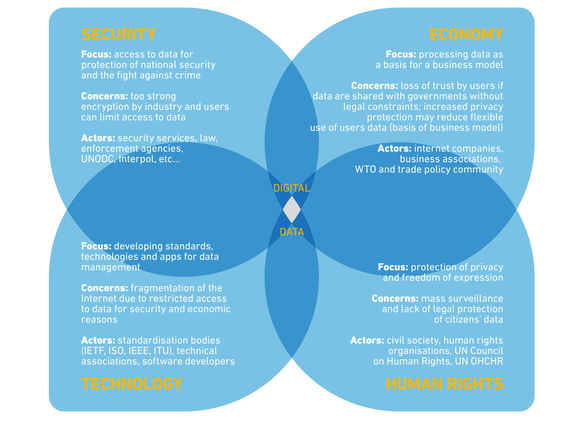The omnipresence of the Internet in modern society makes most digital policy issues transversal. Yet, a transversal approach is more an exception than a rule in digital policy, on both national and international level. For example, data protection is rarely addressed in a holistic way, including security, human rights, economic, and technical perspectives (see illustration), e-commerce, the fight against cybercrime, to name a few, which require a holistic approach as well.
Why does bridging policy silos matter? Exclusive sectoral solutions are sub-optimal. For example, if data protection standards are developed without security and human rights considerations, future data-driven applications could have built-in weaknesses. Ultimately, such solutions could impact the core values of an open and stable Internet.
Are policy silos unique to digital policy? No. Policy silos present a challenge in many policy areas. Climate change involves scientific, economic, development, and health policy communities, among others. Similar complexity exists in dealing with migration and humanitarian assistance. Geneva, as an important hub for all of these issues, should facilitate research and exchange in cross-sectoral policy coverage.
What are the limits in dealing with policy silos? Any attempt to bridge policy silos should start from the current social reality. For one thing, we tend to work in social groups of a limited size (according to the Dunbar number, we can maintain a maximum of about 150 stable social relationships), which tends to limit our outreach. In addition, the increased specialization of human knowledge forces us to go deeper into our own narrow policy field, whether it is technology, security or human rights.
With time, policy communities are reinforced by the use of specific language (often an exclusive jargon), acquisition of a tacit understanding of the core concepts, and development of social and professional networks. The fact that existing social dynamics actually undermine a holistic approach to policy issues should be taken into consideration before make any attempt to bridge policy silos. A reality check is essential.
What can be done? An effective way of bridging policy silos is to develop an appropriate context, and use smart nudging to bring different professional and institutional cultures closer together. One practical approach is to encourage the work of individuals who naturally span boundaries by understanding the ethos and language of various policy communities (technical, legal, security). In addition, bridging policy silos should include a focus on language. Language is both a problem, which is usually used to fortify policy silos, and a possible solution. By simplifying the unnecessary use of professional language and reducing the use of abbreviations and acronyms, we can facilitate easier cross-silo communication.
What are the next steps? Following our ongoing research and the Geneva Message (November 2014), the Geneva Internet Platform focuses on bridging policy silos in digital policy by organising discussions with different policy communities (technical, security, human rights, economic) and facilitating training and research activities which foster a cross-sectoral approach to digital policy.

